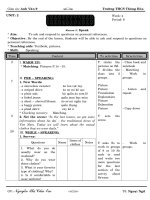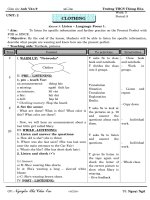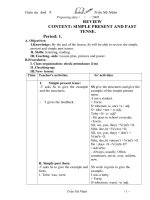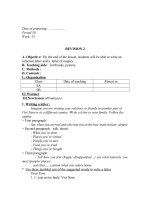Tieng Anh 9 Tiet 66,67,68,69
Bạn đang xem bản rút gọn của tài liệu. Xem và tải ngay bản đầy đủ của tài liệu tại đây (138.38 KB, 9 trang )
Preparing : / 4 / 2011
Teaching : 9A: /4/2011 9B: / 4/ 2011
Period:66 REVIEW
I . Aims :
By the end of this lesson Ss will be able to REVIEW
Language contents :
- Grammar: comparision of adjectives
- Vocabulary: no
Techniques : Brainstorming , elicitation , asking and answering, group work.
Teaching aids : cassette player, extra board, pictures
II . Content :
9A 9B
Stages/ time Contents Notes
Warm up 5’
Activity 1
10’
Activity 2
10’
Chatting
UNIT 6:
1. Adjectives and adverbs ( tính từ và
trạng từ)
+ Tính từ bổ nghĩa cho danh từ và
đại từ.
Ví dụ: Ông ấy là một giáo viên giỏi
" He is a good teacher.
Ông ấy cao "He is tall
+ Trạng từ bổ nghĩa cho động từ và các từ
khác trong câu
Ví dụ: Thầy của tôi dạy giỏi
" My teacher teaches well
Tôi không thể đến đơn giản bỡi vì tôi bị ốm
" I couldn’t come simply because I was
ill.
" It is a very interesting book.
2. Adverbs clauses of reason ( Mệnh đề
trạng ngữ chỉ lí do/nguyên nhân)
+ Mệnh đề trạng ngữ chỉ lí do bắt đầu bằng
as, because hoặc since
As
Because he has no money, he can’t
Since . buy that house
" Vì anh ta không có tiền , anh ta không
thể mua ngôi nhà đó.
Individual work
*Feedback and correction
Teacher introduces the new
structure and gives their
meanings.
Teacher gives students two
pairs of sentences and asks
them to use adjectives
Help students distinguish
between defining Relative
clauses and non- defining
Relative clauses.
* We cannot use “that” in a
non – defining relative
clauses.
*
Activity 3
5’
Activity 4
10’
Homework 5’
Adverbs clauses of reason
Notes: Nếu as, because hoặc since ở đầu
câu thì giữa 2 mệnh đề có dấu phảy (,)và
nếu as, because hoặc since đứng giữa 2
mệnh đề thì không có dấu phảy .
" He can’t buy that house as/
because / since he has no money .
Adverbs clauses of reason
*Nhớ rằng mệnh đề trạng ngữ chỉ lí
do bắt đầu bằng as, because hoặc since
3. Adjective + that clause ( Tính từ +
mệnh đề That)
+I am afraid that I will not come
tomorrow (Tôi e rằng ngày mai
không đến được)
+We’re pleased that you passed
( Chúng tôi hài lòng bạn đã thi đậu)
4. Conditional sentences : type 1
Điều kiện có thể xảy ra hiện tại hoặc tương
lai.
Ví dụ:
+If you work hard, you will pass the exam.
" Nếu bạn làm việc chăm chỉ, bạn sẽ thi
đậu.
+If you can’t do it, I’ll help you. "
Nếu bạn không thể làm điều đó, tôi sẽ giúp
bạn.
- Learn the structures of sentences by heart
- Do some exercises
- Prepare : REVIEW (CONT)
- Remarks
T asks students to work in
pairs
T asks students to do
exercise
T asks students to do
exercise
*Feedback and correction
Whole class
Individual work
- Give feedback
*Write it up
III . Evaluation
Preparing : / 4 / 2011
If clause
Mệnh đề If ( mệnh
đề phụ)
Main clause
Mệnh đề chính
Present tense Will + verb
(without TO )
Teaching : 9A: /4/2011 9B: / 4/ 2011
Period:67 REVIEW 2
I . Aims :
By the end of this lesson Ss will be able to REVIEW
Language contents :
- Grammar: comparision of adjectives
- Vocabulary: no
Techniques : Brainstorming , elicitation , asking and answering, group work.
Teaching aids : cassette player, extra board, pictures
II Content :
9A 9B
Stages/ time Contents Notes
Warm up 5’
Activity 1
15’
Activity 2
15’
UNIT 7
1) Connectives (Liên từ) " Dùng để nối 2
câu/ đoạn văn thành 1 (and,but,because,
or, so, therefore, however)
Ví dụ: + I am a student and he is a
student , too.
+ I am tall, but he isn’t.
+ Nam failed in his exam because he didn’t
study.
+ Would you like tea or coffee ?
+ Ba was very tired, so he went to early.
+ I passed the test, therefore, my dad took
me to the concert.
+ Lan is very tired, however, she must
finish her works.
2) Phrasal verbs: (Cụm động từ) đi sau
kèm động từ là một giới từ và mang một ý
nghĩa khác
turn off (tắt), turn on(mở), look
for (tìm kiếm), look after ( chăm sóc), go
on(tiếp tục)
- He forgot turn off the lights when he
went to bed. ( Anh ấy quên tắt đèn khi đi
ngủ)
- Turn on the light! It’s very dark here.
( Hãy mở dùm đèn lên! Trời tối quá)
- What are you looking for? ( Bạn đang tìm
kiếm gì đấy?)
Individual work
*Feedback and correction
Teacher introduces the new
structure and gives their
meanings.
Teacher gives students two
pairs of sentences and asks
them to use adjectives
Help students distinguish
between defining Relative
clauses and non- defining
Relative clauses.
* We cannot use “that” in a
non – defining relative
clauses.
T asks students to work in
pairs
T asks students to do
exercise
Activity 3
5’
Homework 5’
- The doctor often looks after the patients
in the hospital. (Ở Bệnh viện bác sĩ thường
chăm sóc bệnh nhân)
- If you go on doing that, you’ll be
punished. ( Nếu bạn tiếp tục làm điều đó
bạn sẽ bị phạt)
3) Making suggestions: ( Đưa ra lời đề
nghị)
SUGGEST + VERB- ING,
- I suggest speaking English in class. ( Tôi
đề nghị nói tiêng Anh trong lớp)
SUGGEST (THAT) + S +
SHOULD
- I suggest (that) he should go to see the
doctor. (Tôi đề nghị anh ấy nên đi khám
bác sĩ)
- Learn the structures of sentences by heart
- Do some exercises
- Prepare : REVIEW (CONT)
- Remarks
T asks students to do
exercise
*Feedback and correction
Whole class
Individual work
- Give feedback
*Write it up
III . Evaluation
Preparing : / 4 / 2011
Teaching : 9A: /4/2011 9B: / 4/ 2011
Period:68 REVIEW 3
I Aims :
By the end of this lesson Ss will be able to REVIEW
Language contents :
- Grammar: comparision of adjectives
- Vocabulary: no
Techniques : Brainstorming , elicitation , asking and answering, group work.
Teaching aids : cassette player, extra board, pictures
II. Content:
9A 9B
Stages/ time Contents Notes
Warm up 5’
Activity 1
20’
Activity 2
15’
Chatting
UNIT 8
1) Relative clauses ( Mệnh đề quan hệ)
Đại từ quan hệ : WHO,WHOM,
WHICH, THAT
+ Who : thay thế cho từ chỉ người đứng
trước nó làm chủ từ.
+ Whom: thay thế cho từ chỉ người đứng
trước nó làm tân ngữ.
+ Which : thay thế cho từ chỉ vật, con vật
đứng trước nó làm chủ từ và tân ngữ.
+ That : thay thế cho Who, whom, which
Defining Defining
and non-
defining
SUBJECT
People That Who
Things Which
OBJECT
People (that) Whom
Things Which
POSSESSIVE
People whose Whose
Things Whose/
of which
Whose/
of which
Ví dụ: 1.The woman who wears a hat is my
sister.
2.The man whom you saw yesterday is your
teacher.
3.The book which is on the table is hers.
4.The bag which you are holding in your hand
is our teacher.
+ That : có thể thay thế cho Who, whom,
which ở 4 câu trên.
1.The woman that wears a hat is my sister.
2.The man that you saw yesterday is your
teacher.
3.The book that is on the table is hers.
4.The bag that you are holding in your hand is
our teacher.
Note: Whose dùng để thay thế cho tính từ sở
hữu of which/ whose thay thế cho từ chỉ sở
hữu của vật, con vật.
Eg: The man is our teacher. His book
is on the table.
" The man is our teacher whose book is on
the table.
You are sitting the chair. The leg
of the chair was broken yesterday.
" You are sitting the chair of
which the leg was broken yesterday.
Individual work
*Feedback and
correction
Teacher introduces the
new structure and gives
their meanings.
Teacher gives students
two pairs of sentences
and asks them to use
adjectives
Help students distinguish
between defining
Relative clauses and non-
defining Relative clauses.
* We cannot use “that” in
a non – defining relative
clauses.
*
T asks students to work
in pairs
T asks students to do
exercise
T asks students to do
exercise
*Feedback and
correction
Whole class
III . Evaluation
Preparing : / 4 / 2011
Teaching : 9A: /4/2011 9B: / 4/ 2011
Period:69 REVIEW 4
I . Aims :
By the end of this lesson Ss will be able to REVIEW
Language contents :
- Grammar: comparision of adjectives
- Vocabulary: no
Techniques : Brainstorming , elicitation , asking and answering, group work.
Teaching aids :
cassette player, extra board, pictures
II. Content:
9A 9B
Stages/ time Contents Notes
Warm up 5’
Activity 1
10’
Activity 2
10’
Chatting
UNIT 9 = UNIT 8
1 Relative clauses ( Mệnh đề
quan hệ)
Đại từ quan hệ : WHO,WHOM,
WHICH, THAT
* Phải dùng “that” trong các trường
hợp sau
a) Cụm danh từ hỗn hợp chỉ
người và vật
Eg: The girls and flowers that he
painted were vivid.
They saw the men and women and
cattle that went to the field.
b) Sau tính từ so sánh nhất và the
first, the last, the only…
Eg: She is the ugliest girl that I’ve
ever seen.
c) Sau các đại từ bất định all,
nothing, nobody, anything,
much, little…
Eg: + I have never seen anyone
that is as lovely as she.
+ Much that I have ever seen is
interesting.
Note: *Không được dùng “that” trong
các trường hợp sau
1. a) Có giới từ đứng trước đại từ
quan hệ.
The house in which I live is my
father’s. Câu này có giới từ IN
*Không được dùng “that” để thay
thế cho in which
b) Mệnh đề quan hệ không giới
hạn ( non- defining )
Vietnam, which is on the south-
east Asia, exports rice.
" (which is on the south-
east Asia ) là mệnh đề không giới
hạn *Không được dùng “that” để thay
thế cho which
UNIT 10
1) Modals: may, might ( Động từ
khiếm khuyết may, might )
Động từ khiếm khuyết may, might
chỉ khả năng có thể xảy ra ở hiện tại
hoặc tương lai. Tuy nhiên might có
Individual work
*Feedback and correction
Teacher introduces the new
structure and gives their
meanings.
Teacher gives students two pairs
of sentences and asks them to
use adjectives
Help students distinguish
between defining Relative
clauses and non- defining
Relative clauses.
* We cannot use “that” in a non
– defining relative clauses.
*
T asks students to work in pairs
T asks students to do exercise
T asks students to do exercise
*Feedback and correction
Whole class
Individual work
III . Evaluation









